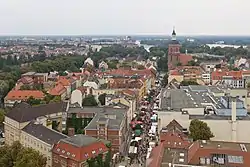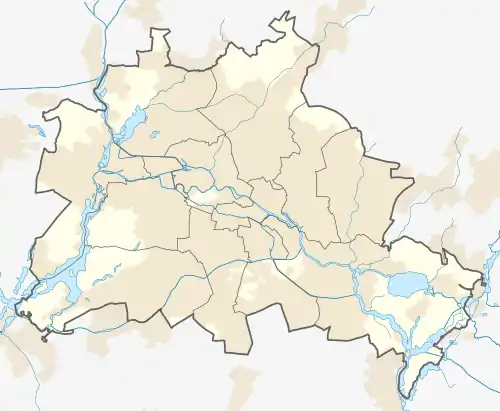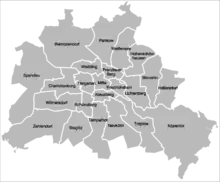Spandau
Spandau (German: [ˈʃpandaʊ̯] (![]() listen)) is the westernmost of the twelve boroughs (Bezirke) of Berlin, situated at the confluence of the Havel and Spree rivers and extending along the western bank of Havel. It is the smallest borough by population, but the fourth largest by land area.
listen)) is the westernmost of the twelve boroughs (Bezirke) of Berlin, situated at the confluence of the Havel and Spree rivers and extending along the western bank of Havel. It is the smallest borough by population, but the fourth largest by land area.
Spandau | |
|---|---|
Borough of Berlin | |
 Old town of Spandau | |
 Coat of arms | |
Location of Spandau in Berlin .svg.png.webp) | |
 Spandau  Spandau | |
| Coordinates: 52°33′N 13°12′E | |
| Country | Germany |
| State | Berlin |
| City | Berlin |
| Subdivisions | 9 localities |
| Government | |
| • Mayor | Helmut Kleebank (SPD) |
| Area | |
| • Total | 91.91 km2 (35.49 sq mi) |
| Population (2012-11-30) | |
| • Total | 231,540 |
| • Density | 2,500/km2 (6,500/sq mi) |
| Time zone | UTC+01:00 (CET) |
| • Summer (DST) | UTC+02:00 (CEST) |
| Vehicle registration | B |
| Website | www |
Overview
Modern industries in Spandau include metalworking, and chemical and electrical factories. BMW Motorrad's Spandau factory made all BMW's motorcycles from 1969 until final assembly plants were added in Rayong, Thailand in 2000, and Manaus, Brazil in 2016.[1][2][3]
Rathaus Spandau, Spandau's seat of government, was built in 1913. Other landmarks include the Renaissance fortress Spandau Citadel, built in 1594, the 1848 St. Marien am Behnitz Catholic church designed by August Soller, and Spandau arsenal, Germany's arms development center until 1919, now a museum. That arsenal's Spandau pistol inspired the slang Spandau Ballet to describe dying soldiers on barbed wire during the First World War, and later was applied to the appearance of Nazi war criminals hanged at Spandau Prison. The notorious prison, built in 1876, held Nazi war criminals after World War II until 1987, when it was demolished after the death of the last surviving prisoner, Rudolf Hess.[4] In 1979, the English New Romantic band Spandau Ballet again re-purposed the term for its name.
After World War II Spandau fell into the British and American sector of West Berlin during the Allied occupation. Gatow airfield in the south of the district, was used by the Royal Air Force, most notably during the Berlin Airlift. Since 1995 the airfield is now the Museum of Military History.
Geography
Spandau's neighbors outside Berlin are the districts (Kreis) of Oberhavel to the north, and Havelland to the west, and the city of Potsdam, Brandenburg, to the southwest. Within Berlin, it borders the boroughs of Steglitz-Zehlendorf to the south, Charlottenburg-Wilmersdorf to the east, and Reinickendorf to the northeast. Its land area of 91.91 km2 (35.49 sq mi) is the fourth largest of the twelve boroughs.
Demographics
As of 2010, Spandau had a population of 223,962, the smallest of the twelve boroughs. There were 62,000 migrants or other non-ethnic Germans, comprising 27% of Spandau's population.[5]
| Percentage of people with migration background[5] | |
|---|---|
| Germans without migration background/Ethnic Germans | 165,000 (73%) |
| Germans with migration background or foreign citizens | 62,000 (27%) |
| Middle Eastern origin (Turkey, Arab League, Iran etc.) | 20,400 (9%) |
| (non-German) EU-European migration background (esp. Poles, Romanians etc.) | 13,600 (6%) |
| African background/Afro-Germans (Ghana, Nigeria, Cameroon etc.) | 7,000 (3%) |
| Others (East Asians, Russians, Serbs etc.) | 20,400 (9%) |
Politics
.svg.png.webp)
At the 2016 elections for the parliament of the borough (Bezirksverordnetenversammlung) the following parties were elected:
People
- Bela B., musician, born 14 December 1962
- Hans Berndt, football player (1913–1988)
- Helmut Bonnet, athlete (1910–1944)
- Käthe Heinemann, pianist (1891–1975)
- Robert Hoyzer, former football referee, born 28 August 1979
- Käthe Itter, actress (1907–1922)
- Paul Kellner, swimmer (1890–1972)
- Henning Alexander von Kleist, Governor of the Spandau citadel, died there in 1784
- Rosa Lindemann, communist (1856–1958)
- Arthur Löwenstamm, Spandau Synagogue's first and only rabbi, from 1917 to 1938
- Moriz von Lyncker, Prussian officer and Chief of the Military Cabinet of Emperor Wilhelm II. (1853–1932)
- Christian Friedrich Neue, philogist (1789–1886)
- Oliver Petszokat, singer, born 10 August 1978
- Hans von Plessen, Prussian Colonel General (1841–1929)
- Ivan Rebroff, singer, born 31 July 1931, died 27 February 2008 in Frankfurt
- Erna Sack, soprano, born 6 February 1898, died 2 March 1972 in Mainz
- Sıla Şahin, actress, born 3 December 1985
- Richard Schulze-Kossens, SS commander during the Nazi era (1914–1988)
- Franz Hermann Troschel, zoologist (1810–1882)
- Carl Albert Weber, botanist, (1856–1931)
- Kai Wegner, politician (CDU), born 15 September 1975
Twin towns
Spandau's town twinning (sister city) partners are:
 Luton, United Kingdom since 1950
Luton, United Kingdom since 1950 Siegen, Germany since 1952
Siegen, Germany since 1952 Asnières-sur-Seine, France since 1959
Asnières-sur-Seine, France since 1959 Ashdod, Israel since 1968
Ashdod, Israel since 1968 Iznik, Turkey since 1987
Iznik, Turkey since 1987 Nauen, Germany since 1988
Nauen, Germany since 1988
![]() Boca Raton, Florida, United States was a sister city from 1979 to 2003.
Boca Raton, Florida, United States was a sister city from 1979 to 2003.
See also
- Berlin Spandau – Charlottenburg North (electoral district)
- Altstadt Spandau, the historic old town
- Spandau Synagogue
- Monuments in Spandau (German Wikipedia)
References
- "my FB Title". Be.berlin.de. Retrieved 17 January 2018.
- Henry, Ian (6 January 2015). "BMW: Global growth". Automotive Manufacturing Solutions. Ultima Media. Retrieved 17 January 2018.
- "BMW Motorrad expands production network with its own manufacturing site in Brazil. [press release]". BMW Group. 4 April 2016. Retrieved 17 January 2018.
- Goda, Norman J. W. (2006). Tales from Spandau. University of Florida. ISBN 978-0-521-86720-7.
- "Melderechtlich registrierte Einwohner im Land Berlin" (PDF). Statistik-berlin-brandenburg.de. 31 December 2010. Retrieved 17 January 2018.
Further reading
- Zeller, Frederic (1989). When Time Ran Out: Coming of Age in the Third Reich. London: W H Allen. ISBN 0-491-03614-0.
External links
| Wikimedia Commons has media related to Spandau. |
- (in German) Official homepage
- Official homepage of Berlin
- "Unterwegs in Spandau": Sehenswürdigkeiten, News, Veranstaltungshinweise und Berichte aus Spandau

